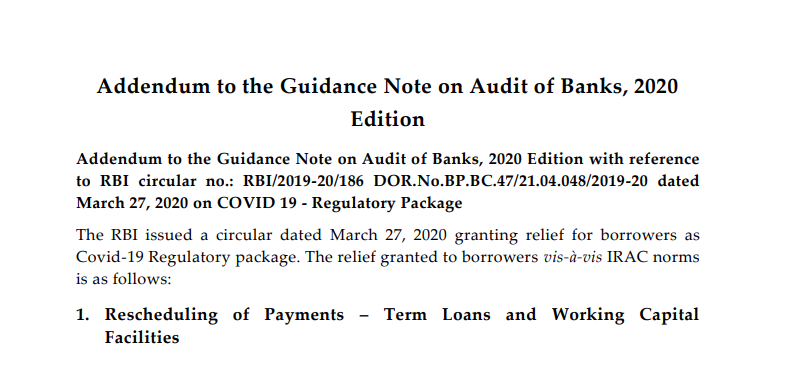Addendum to the Guidance Note on Audit of Banks, 2020 Edition: ICAI
- Addendum to the Guidance Note on Audit of Banks, 2020 Edition
- 1. Rescheduling of Payments – Term Loans and Working Capital Facilities
- 1.1. Term Loans
- 1.2. Working Capital Facilities
- 1.3. Other facilities like LCBD, Bill Discounting, etc.
- 1.4. Investments
- 2. Easing of Working Capital Financing
- 3. Classification as Special Mention Account (SMA) and Non-Performing Asset (NPA)
- 4. Applicability of the circular
- 1. Term Loans
- 2. Working Capital Facilities
- 3. Provisioning
- 3.1. Term Loans
- 3.2. Working Capital Facilities
- Download the copy:
Addendum to the Guidance Note on Audit of Banks, 2020 Edition
Addendum to the Guidance Note on Audit of Banks, 2020 Edition with reference to RBI circular no.: RBI/2019-20/186 DOR.No.BP.BC.47/21.04.048/2019-20 dated March 27, 2020, on COVID 19 – Regulatory Package
The RBI issued a circular dated March 27, 2020, granting relief for borrowers as Covid-19 Regulatory package. The relief granted to borrowers vis-à-vis IRAC norms is as follows:
1. Rescheduling of Payments – Term Loans and Working Capital Facilities
1.1. Term Loans
In respect of all term loans (including agricultural term loans, retail and crop loans), all commercial banks (including regional rural banks, small finance banks and local area banks), co-operative banks, all-India Financial Institutions, and NBFCs (including housing finance companies) (‚lending institutions‛) are permitted to grant a moratorium of three months on payment of all instalments falling due between March 1, 2020, and May 31, 2020. The repayment schedule for such loans as also the residual tenor will be shifted across the board by three months after the moratorium period. Interest shall continue to accrue on the outstanding portion of the term loans during the moratorium period.
Related Topic:
Compilation for Statutory Audit of Bank Branches (2019-20)
The banks have been permitted to grant a moratorium period of three months on payment of all instalments to all types of term loans which are falling due between March 01, 2020, and May 31, 2020, and accordingly the residual tenor of the account would be extended to the extent of such moratorium period granted. The footnote to the circular specifies that Instalments will include the following payments falling due from March 1, 2020, to May 31, 2020: (i) principal and/or interest components; (ii) bullet repayments; (iii) Equated Monthly instalments; (iv) credit card dues.
However, the circular is silent as regards the absorbing of the interest which would be payable by the borrower during the moratorium period of three months as to whether the same would result in incremental EMIs for the residual period or the residual period gets extended for the requisite period beyond the expected extension of three months. It may be presumed that the banks would be permitted to follow either of the two options. They would need to mention the option that will be followed in the Board approved policy in this regard. Further, as regards the applicability of IRAC norms, the relief in the form of moratorium period does not have any impact.
1.2. Working Capital Facilities
In respect of working capital facilities sanctioned in the form of cash credit/overdraft (‚CC/OD‛), lending institutions are permitted to defer the recovery of interest applied in respect of all such facilities during the period from March 1, 2020, up to May 31, 2020 (‚deferment‛). The accumulated accrued interest shall be recovered immediately after the completion of this period.
The banks have been permitted to defer the recovery of interest applied to working capital finance facilities during the period March 01, 2020, up to May 31, 2020. Thus, the interest debited to the account during the period March 01, 2020, up to May 31, 2020, would be considered as ‘not due’ till May 31, 2020. Hence, while applying the yardsticks of ‘out of order’ status for such accounts, the interest component would be required to be excluded during the period March 01, 2020, to May 31, 2020. However, the said interest which is considered as ‘not due’ during such period, would be required to be considered as due on June 01, 2020.
As regards the applicability of IRAC norms, the relief in the form of deferment of interest during the said period will have limited impact to the extent of following while applying three yardsticks of ‘out of order’ status of an account, viz., if the outstanding balance remains continuously in excess of the sanctioned limit/drawing power for 90 days, or in cases where the outstanding balance in the principal operating account is less than the sanctioned limit / drawing power, but there are no credits continuously for 90 days as on the date of Balance Sheet or credits are not enough to cover the interest debited during the same period.
1.3. Other facilities like LCBD, Bill Discounting, etc.
The captioned RBI circular does not grant any relief to other facilities like LCBD and Bill Discounting as both are neither in the form of Term Loan nor in the form of Cash Credit / Overdraft facilities.
1.4. Investments
The captioned RBI circular does not grant any relief to the Investment portfolio of the bank.
2. Easing of Working Capital Financing
In respect of working capital facilities sanctioned in the form of CC/OD to borrowers facing stress on account of the economic fallout of the pandemic, lending institutions may recalculate the ‘drawing power’ by reducing the margins and/or by reassessing the working capital cycle. This relief shall be available in respect of all such changes effected up to May 31, 2020, and shall be contingent on the lending institutions satisfying themselves that the same is necessitated on account of the economic fallout from COVID19. Further, accounts provided relief under these instructions shall be subject to subsequent supervisory review with regard to their justifiability on account of the economic fallout from COVID-19.
The circular grants discretion to the lending institutions regarding reduction in margin and reassessment of the working capital cycle, during the period up to May 31, 2020. The bank’s board approved policy will need to prescribe the manner of implementing this requirement.
The said relief will have limited impact on the extent of change in the method of calculation of drawing power to the extent of reduction in margin and relaxation in consideration of the working capital cycle.
3. Classification as Special Mention Account (SMA) and Non-Performing Asset (NPA)
The relief granted by banks to the borrower as specified and permitted under the said circular, will not be considered as concession or change in terms and conditions of loan agreements due to financial difficulty of the borrower under paragraph 2 of the Annex to the Reserve Bank of India (Prudential Framework for Resolution of Stressed Assets) Directions, 2019 dated June 7, 2019 (‚Prudential Framework‛). Consequently, such a measure, by itself, shall not result in asset classification downgrade.
However, any relief granted over and above than specified in the said circular may result in asset classification downgrade.
4. Applicability of the circular
The circular does not distinguish between Standard Accounts and NonPerforming Accounts and thus, the benefit of relaxation provided under this circular would be available across classifications of Assets.
Addendum to the Guidance Note on Audit of Banks, 2020 Edition with reference to RBI circular no.: RBI/2019-20/220 DOR.No.BP.BC. 63/21.04.048/2019-20 dated April 17, 2020, on COVID 19 Regulatory Package – Asset Classification and Provisioning
The RBI issued a circular dated April 17, 2020, granting relief w.r.t. Asset Classification and Provisioning as follows:
1. Term Loans
In respect of Term Loan accounts classified as standard as on February 29, 2020, even if overdue, the moratorium period, wherever granted, shall be excluded by the lending institutions from the number of days past-due for the purpose of asset classification under the IRAC norms.
The circular grants relief to the term loan accounts availing moratorium benefit, to the extent of moratorium period granted, by excluding the same while calculating the delinquency for asset classification.
Thus, in case if a Term Loan account has not opted for the moratorium period, the benefit of the exclusion of the period between March 01, 2020, to May 31, 2020, in the calculation of delinquency for asset classification would not be available.
2. Working Capital Facilities
In respect of working capital facilities sanctioned in the form of cash credit/overdraft (‚CC/OD‛), the Regulatory Package permitted the recovery of interest applied during the period from March 1, 2020, up to May 31, 2020, to be deferred (‘deferment period’). Such deferment period, wherever granted in respect of all facilities classified as standard, including SMA, as on February 29, 2020, shall be excluded for the determination of out of order status.
The circular grants relief from testing a CC/OD account for determination of ‘out of order’ status during the intervening period of March 01, 2020, and May 31, 2020. Thus, an account that is standard as on February 29, 2020 (i.e., not out of order status) would remain standard (or in other words in the same category as standard or SMA) till May 31, 2020.
3. Provisioning
3.1. Term Loans
In case of Term Loans, wherein the benefit of moratorium period has been availed and such moratorium period has also been granted for the purpose of calculating the delinquency related to asset classification, on such accounts, a general provision of 10% would be required to be made to the extent of total outstanding in the loan accounts in a phased-wise manner as follows:
(i) Quarter ended March 31, 2020 – not less than 5 per cent
(ii) Quarter ending June 30, 2020 – not less than 5 per cent
The said provision would be applicable only in the cases wherein such accounts would otherwise (i.e., without availing the benefit related to asset classification) have been marked as NPA and the said provisioning requirement will not apply to the accounts which otherwise would have continued to be under the standard category. The following table includes illustrative examples to clarify further:
(Presumption: the account is standard account as at February 29, 2020, and has availed a moratorium period for payment of EMIs for a period of 3 months (March 01, 2020, to May 31, 2020):
| Instalment overdue since | Provision required | Provision required for the quarter |
| December 15, 2019 | Yes | March 2020 – 5%
June 2020 – 5% |
| January 01, 2020 | Yes | March 2020 – 5%
June 2020 – 5% |
| January 15, 2020 | Yes | June 2020 – 10% |
| February 29, 2020 | Yes | June 2020 – 10% |
3.2. Working Capital Facilities
In case of working capital facilities wherein the benefit of exclusion of period of March 01, 2020, to May 31, 2020, is availed, a general provision of 10% would be required to be made to the extent of total outstanding in the loan accounts in a phased-wise manner as follows:
(i) Quarter ended March 31, 2020 – not less than 5 per cent
(ii) Quarter ending June 30, 2020 – not less than 5 per cent
The said provision would be applicable only in the cases wherein such accounts would otherwise (i.e., without availing the benefit related to ‘out of order’) have been marked as NPA and the said provisioning requirement will not apply to the accounts which otherwise would have continued to be under a standard category.
3.3. The above provisions may be adjusted against the actual provisioning requirements for slippages from the accounts reckoned for such provisions. The residual provisions at the end of the financial year can be written back or adjusted against the provisions required for all other accounts.
3.4. The above provisions shall not be reckoned for arriving at net NPAs till they are adjusted against the actual provisioning requirements as specified earlier. Further, till such adjustments, these provisions shall not be netted from gross advances but shown separately in the balance sheet as appropriate.
3.5. The said provision is required to be made to the extent of the balance outstanding in the account wherein such benefit is availed and thus is not required to be made borrower-wise.
4. As regards the accounts which have been marked as NPA as at February 29, 2020, the asset classification norms based on subsequent aging would continue as per usual asset classification. Thus, the relaxation specified in this circular is limited to the extent the borrower accounts which were standard as of February 29, 2020, and not otherwise.
5. It would be pertinent to note that the said circular specifies as regards maintenance of status quo of account classification as at February 29, 2020, up to May 31, 2020, but that does not preclude up-gradation of an NPA account on account of the extinction of delinquencies in the said account due to which the account was classified as NPA (e.g.: In case of Term Loan account, a borrower has repaid the overdue amount to the fullest extent).
6. The circular provides for the disclosure and reporting requirements related to the assets which have availed the asset classification benefit as per the extant relaxation under this circular.
Download the copy:
If you already have a premium membership, Sign In.
 ConsultEase Administrator
ConsultEase Administrator
Consultant
Faridabad, India
As a Consultease Administrator, I'm responsible for the smooth administration of our portal. Reach out to me in case you need help.













